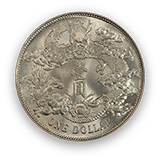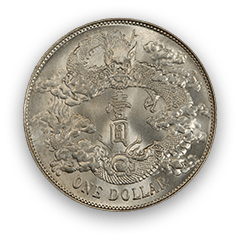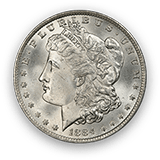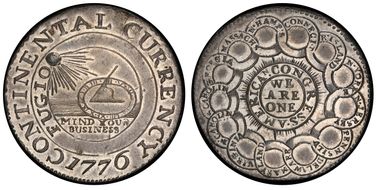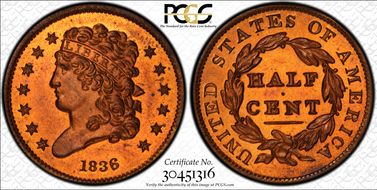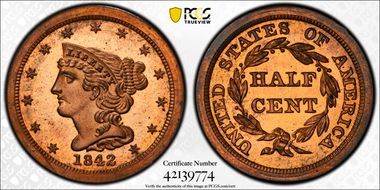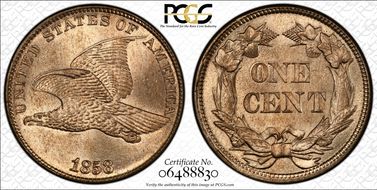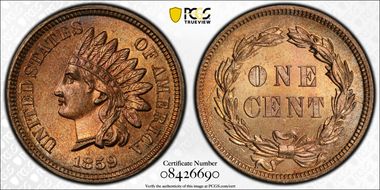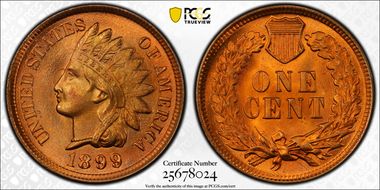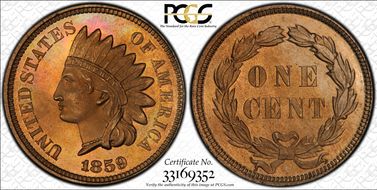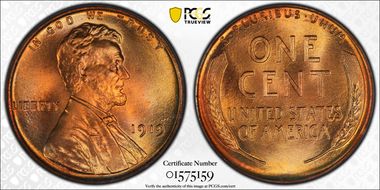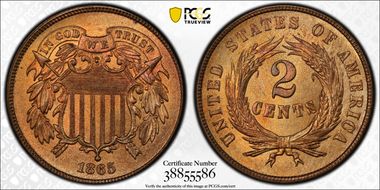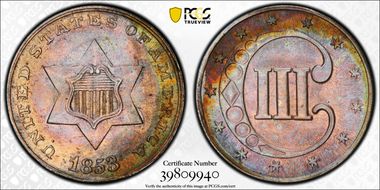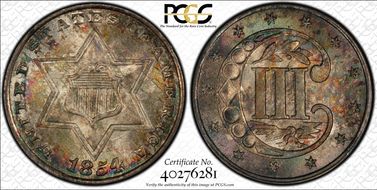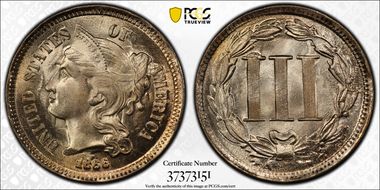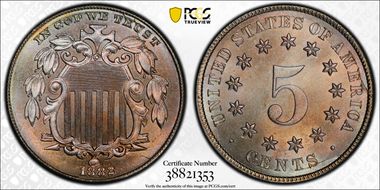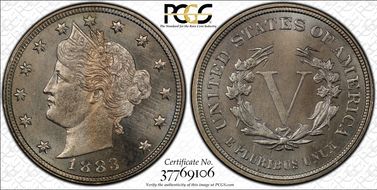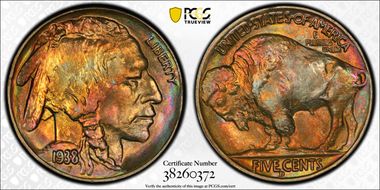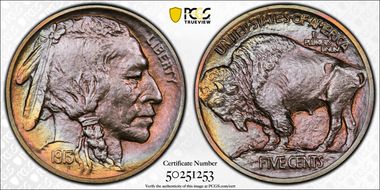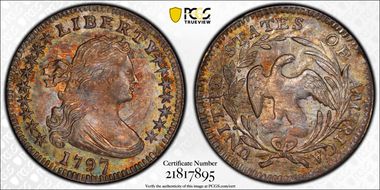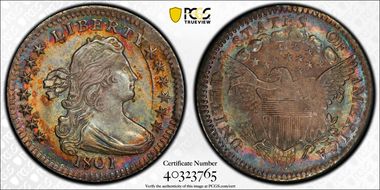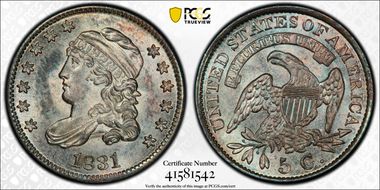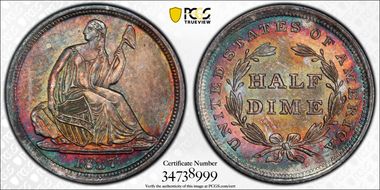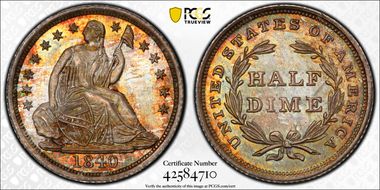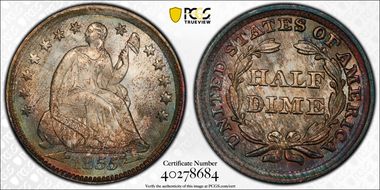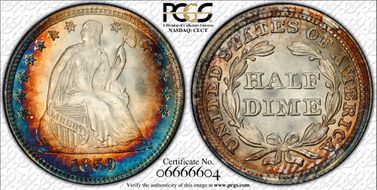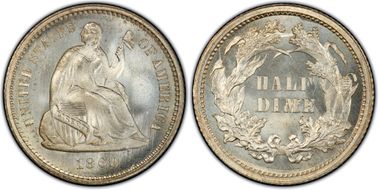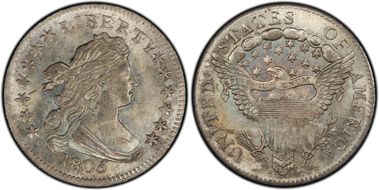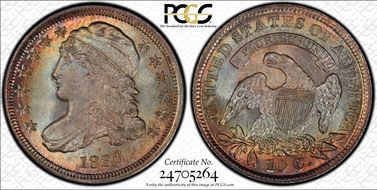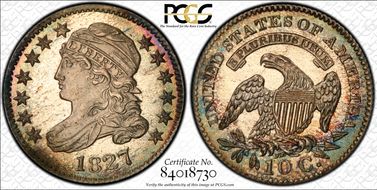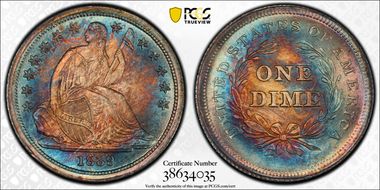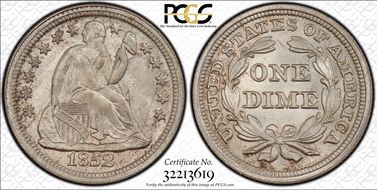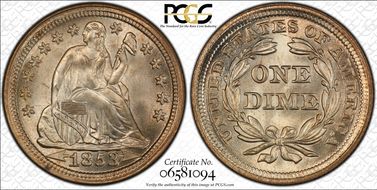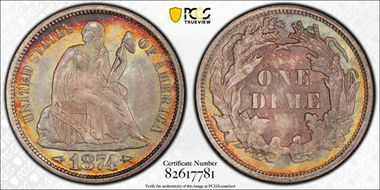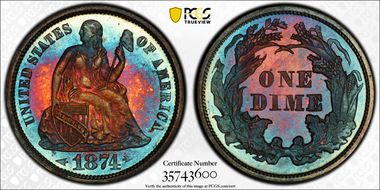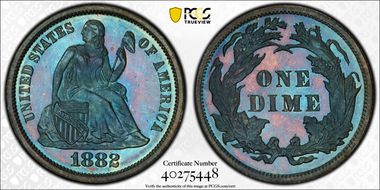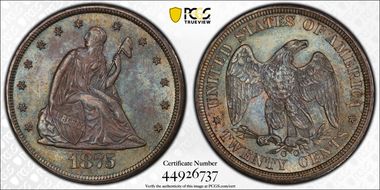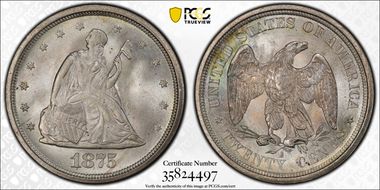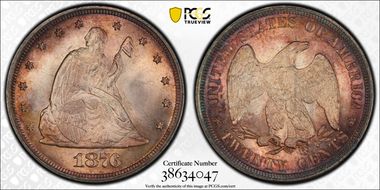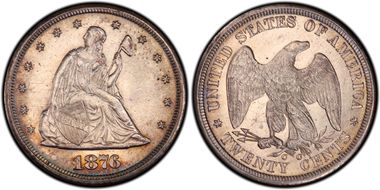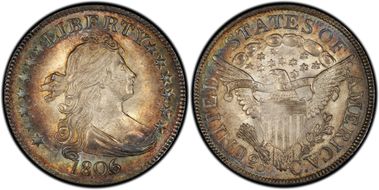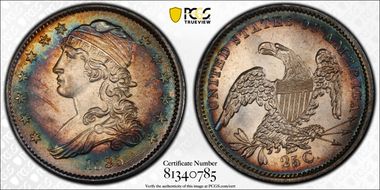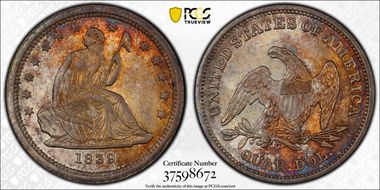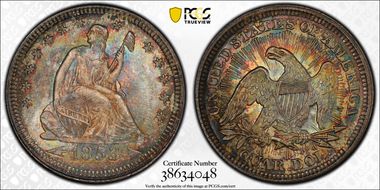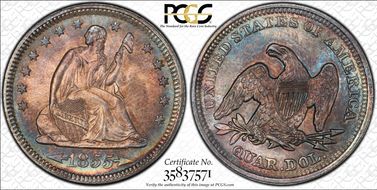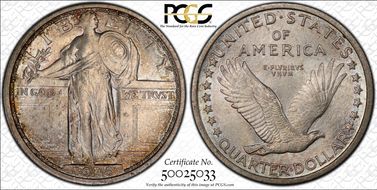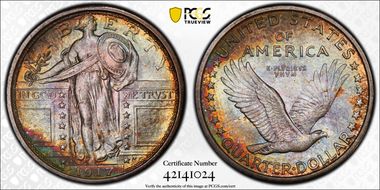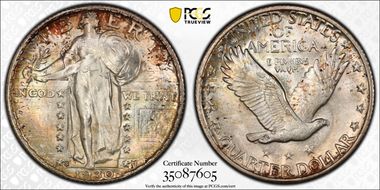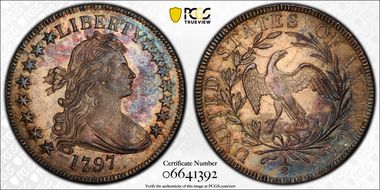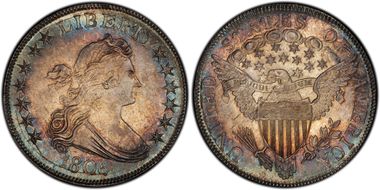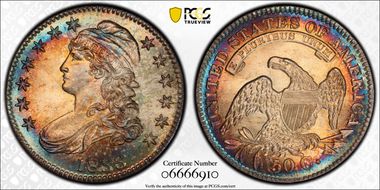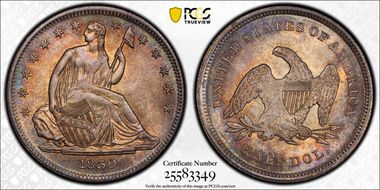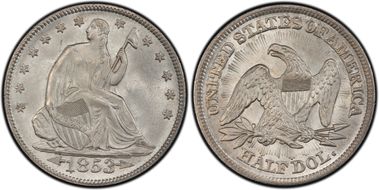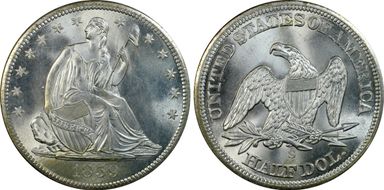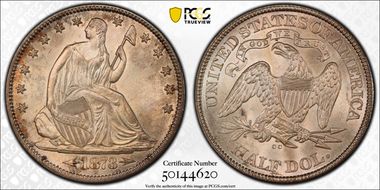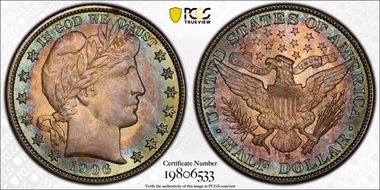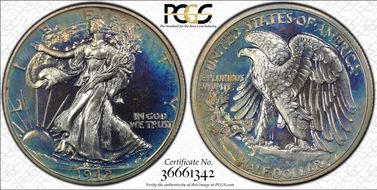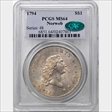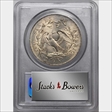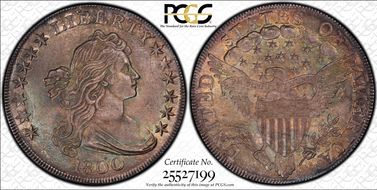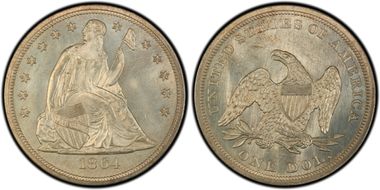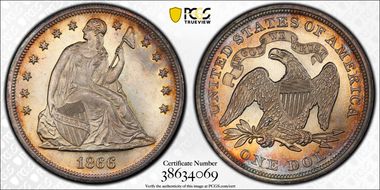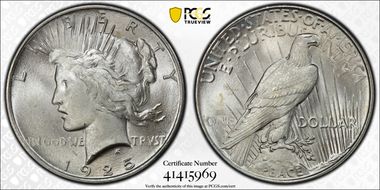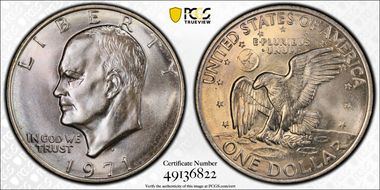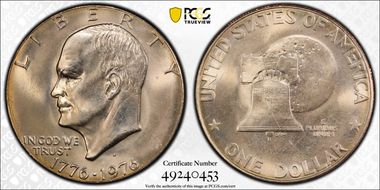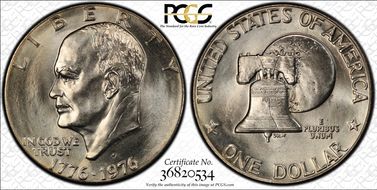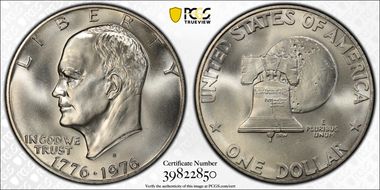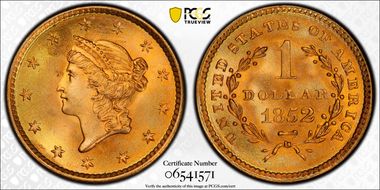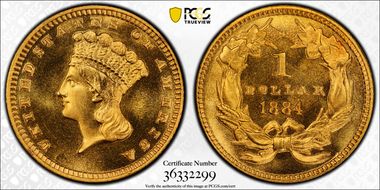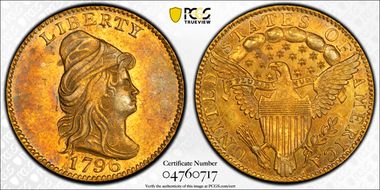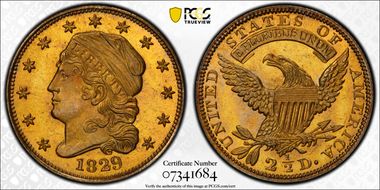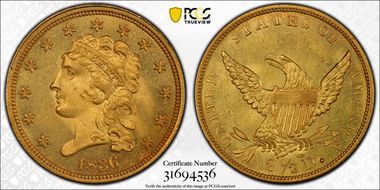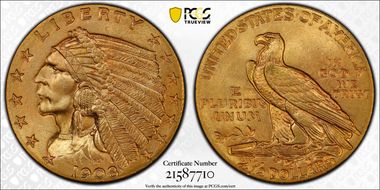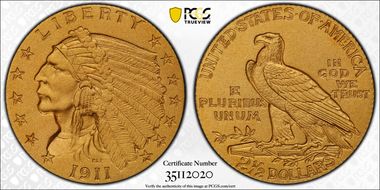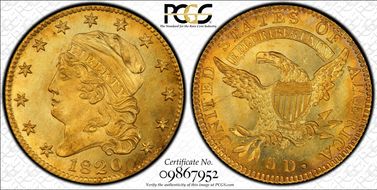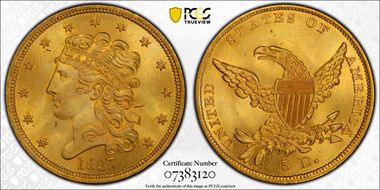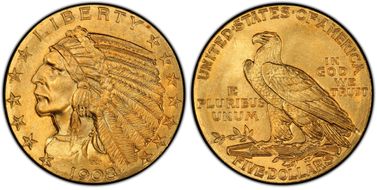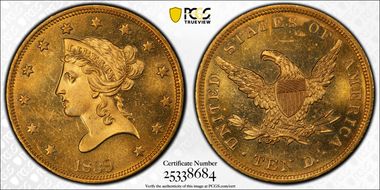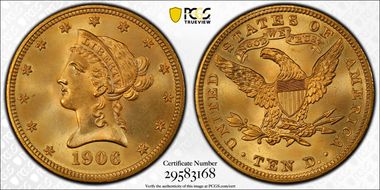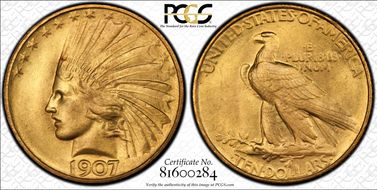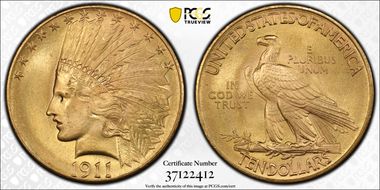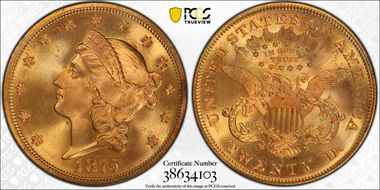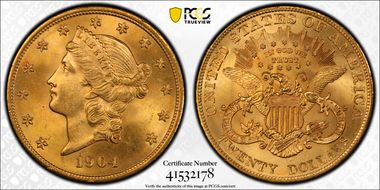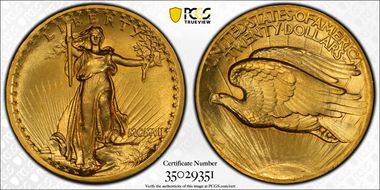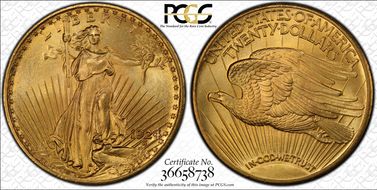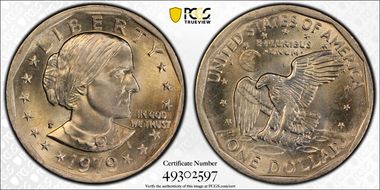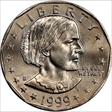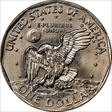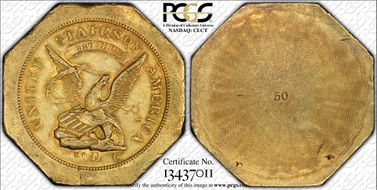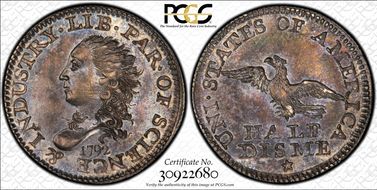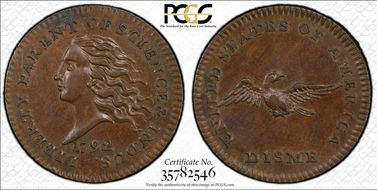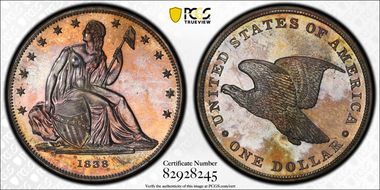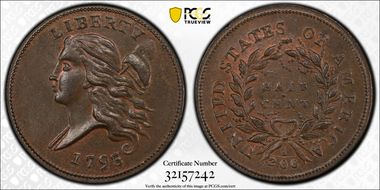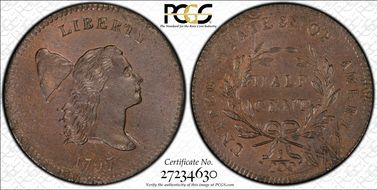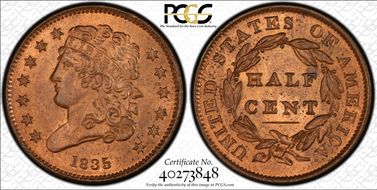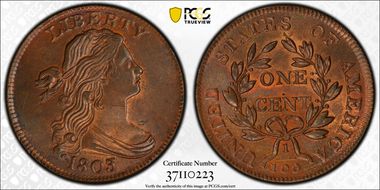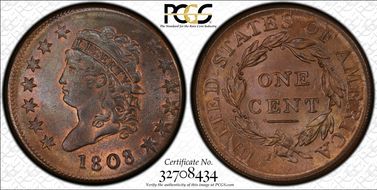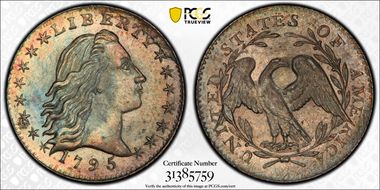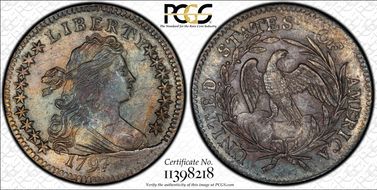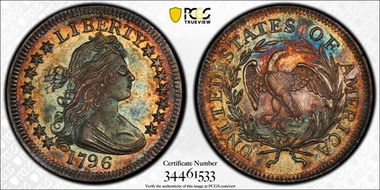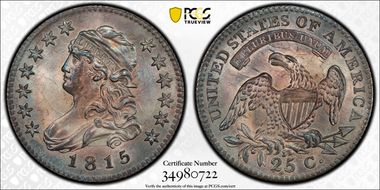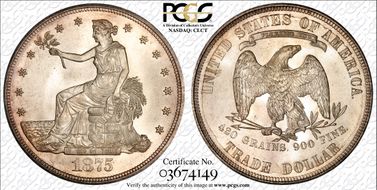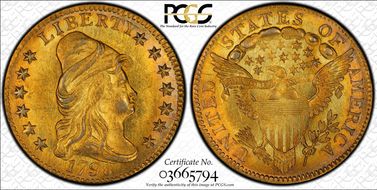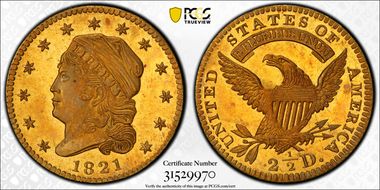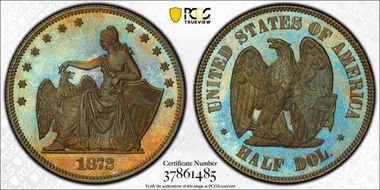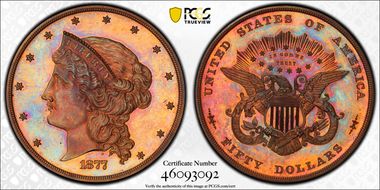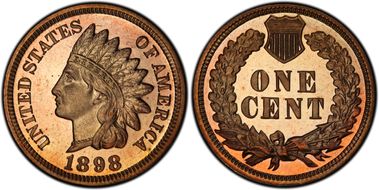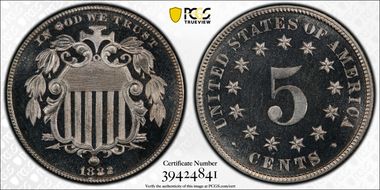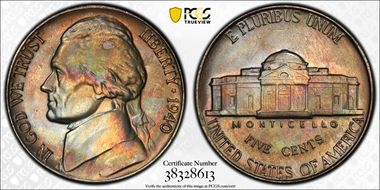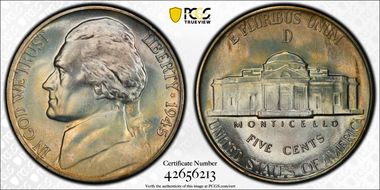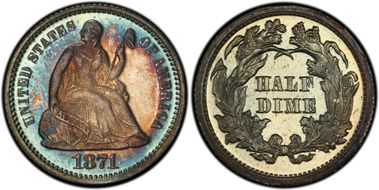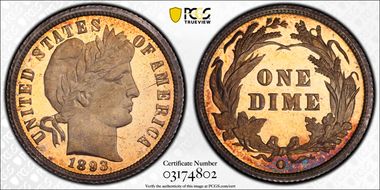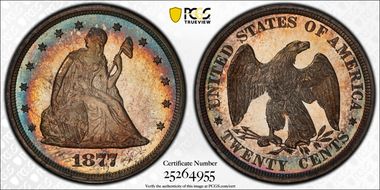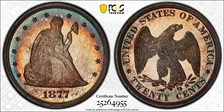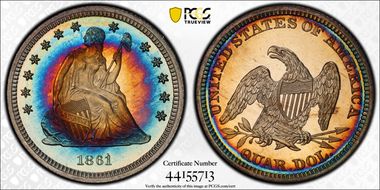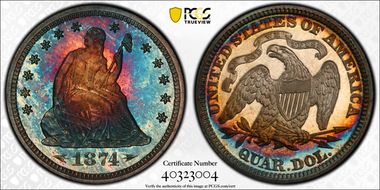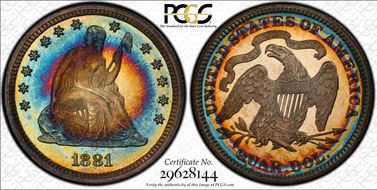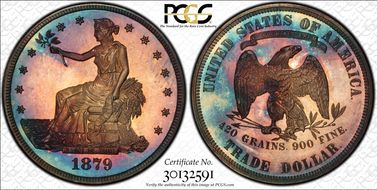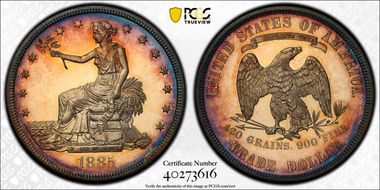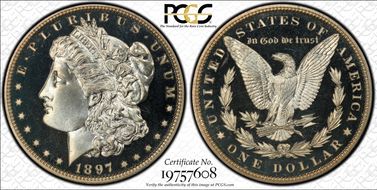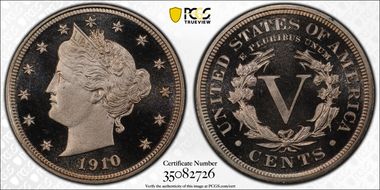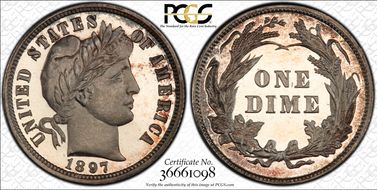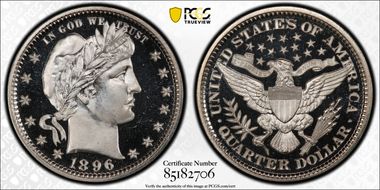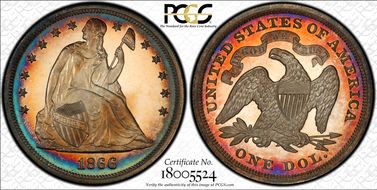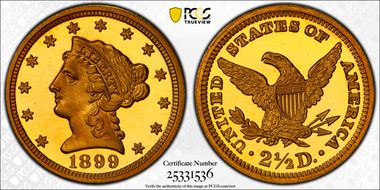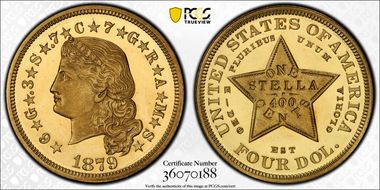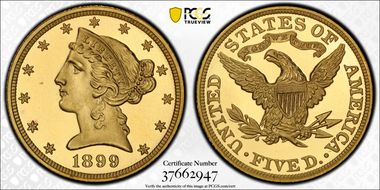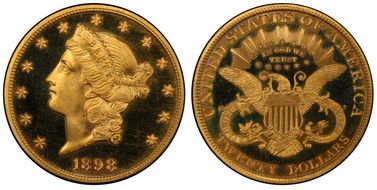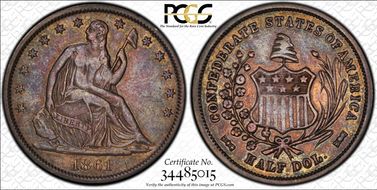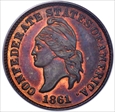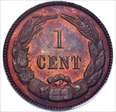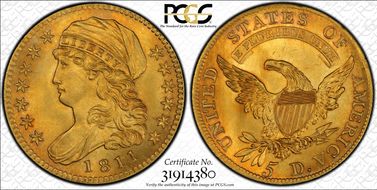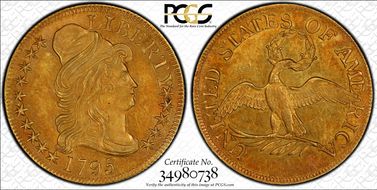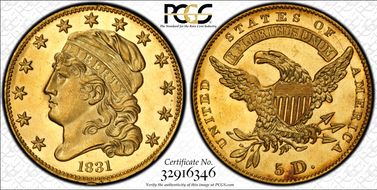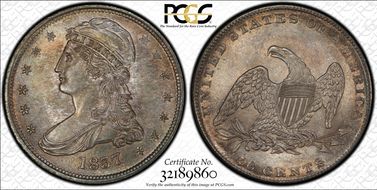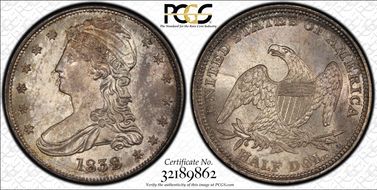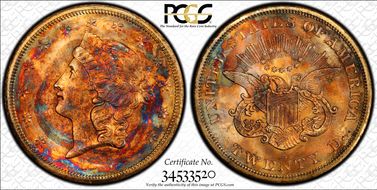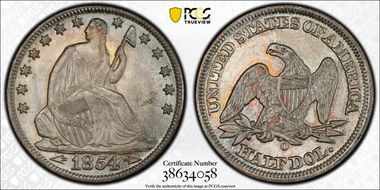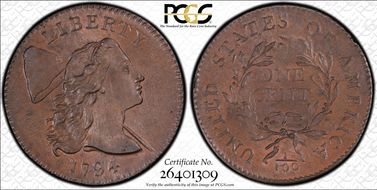Black Cat 的钱币相册
CAC - "This exceptional Wreath cent exhibits extraordinary surfaces and amazing eye appeal. The chestnut-brown surfaces are flawless, the tiny marks at the lower reverse remaining from the planchet. Traces of faded mint red remain visible on this extraordinary Wreath cent. Alan Weinberg's Commentary: Simply the finest S-10 Wreath known. Incredible coruscating luster." Ex: Alan V. Weinberg Collection.
CAC - "The Duckor 1919 Lincoln cent is sharp and luminous, yielding untouched frosty luster with no discernible carbon spotting. Coloration transitions between rose-red, orange, gold, and faint greenish hues, all within the scope of the Red category. The originality is unquestioned. Housed in a green label holder with a green CAC label" Ex: The Dr. and Mrs. Steven Duckor Collection of Lincoln Cents
CAC - "The mint luster is thick and frosty, the strike is essentially full, producing complete detail on all peripheral elements -- remarkable in itself. Finally, the patina, consisting of flecks of iridescent cherry, cobalt-blue, mint-green, pale lavender, and amber-gold, is especially attractive, contrasting against light silver-gray areas." Ex: he Bob R. Simpson Collection, Part III
CAC - "PCGS estimates a survivorship of approximately 100 coins in all grades. This Superb Gem proof is sharp and beautifully toned, with reflective fields and natural multicolor hues." Ex: The Bob R. Simpson Collection, Part IV
CAC - "A satiny glow radiates boldly on both sides, amplifying the razor-sharp devices and delicate toning. A ring of tangerine-rose yields to sky-blue and silver color."
CAC - "Sharply struck on both sides, this pleasing GEM has a strong luster that comes out with a brilliant vibrance that glows in the light and underlies a sumptuous, original patination. Golds, blues, and greens blend over pearly-silver surfaces. The design elements are very sharp overall with only some minor and typical weaknesses in the central devices of the eagle. Struck from clashed dies, parts of the reverse wreath can be seen in the field in front of Liberty's portrait. The eye appeal is exceptional and the quality is stunning!" Ex. Oliver Jung and Bruce Morelan Collection.
CAC - Wonderful rainbow toning on both sides which varies from russet to gold with a touch of blue. The toning deepens around the reverse rim, while the centers are brighter with antique flecks of color intermixed. Boldly struck and the coin has reflective field surfaces, reflecting careful die polishing.
CAC - "both sides are a vibrant frosty white. Miss Liberty and the details are thickly frosted and have crisp strikes"
CAC - "Both sides of this remarkably well preserved 4 Berries dime offer violet, sky blue and golden pastels on highly lustrous and satiny surfaces. Liberty's portrait stands out with bold to sharp definition. The hair detail, in fact, is just a few strands shy of complete. The reverse delivers full wing feathers for the eagle and very well struck stars. Intriguing die clash (as made) is observable around the central motifs. Exceptionally attractive and among the finest examples extant for the type, issue and variety". Ex. Douglas C. Kaselitz Collection
CAC - "A remarkable proof type coin. Rich powder-blue and lilac-red toning alternates across undisturbed surfaces." Ex. The Bob R. Simpson Collection
CAC - "The obverse shows a silver center framed with rings of amber-gold, aqua, jade, violet, and russet nearest the rims. The reverse is also silver in the centers, with russet-gold and cobalt-blue peripheral accents. ....... the eye appeal is simply off the charts." Ex "Col." E.H.R. Green/Newman.
CAC -Ex Gardner, Jung. "This is arguably the finest known 1839 Liberty Seated Quarter, and one of the top few finest known of the ‘No Drapery’ type."
CAC - "Beautiful and original multicolored toning cascades over both sides of this stunning high-end Gem. Gold and silver-gray coloration imbued with whispers of soft bluish-violet, orange, and russet predominate, accented with splashes of deep electric-blue, violet, reddish-gold, and purple at the upper-right and right obverse and on the lower-right quadrant of the reverse. Reflective prooflike fields highlight the frosty central motifs, yielding a pleasing degree of contrast on each side. The design elements are sharply struck, including individual strands of Liberty's hair and curls. The eagle's wing and tail feathers are bold, as are the talons. A curving, as-made lintmark is visible just above Liberty's cleavage, and light horizontal adjustment marks at the left and right reverse border do not affect the clarity of the letters in UNITED and AMERICA. The few minuscule marks that are visible only under a glass are insignificant and unobtrusive. Indeed, the surfaces on both sides are remarkably well-preserved." This easily one of the two finest 1797 halves certified. Ex: Farish Baldenhofer Collection (Stack's, 11/1955), lot 676; Norweb Collection (Bowers and Merena, 11/1988), lot 3027; Dr. Haig A. Koshkarian Collection (American Numismatic Rarities, 3/2004), lot 76; Stack's (7/2008), lot 4261, The Collection of Oliver Jung (Heritage, 8/2014), lot 5582, The Jim O'Neal Collection of U.S. Half Dollar Types.(Heritage, 1/2023), lot 3701
CAC - One of two MS68 coins for the Type at PCGS (4/24). "The overall color scheme is one of reddish-orange patina yielding to vivid electric-blue highlights at the denticles. The right obverse, however, displays mottled sea-green overtones intermingled with silver-tinged near-brilliance. The impression is expertly centered on the planchet with fully evident denticulation bordering devices that are sharply delineated in virtually all areas. Lustrous with a softly frosted texture, the surfaces are uncommonly blemish-free."
CAC - The finest endorsed CAC coin (as a plus) - A very challenging coin. "Each side displays medium-density reddish-golden patina, with accents of blue around the margins. There is no sign of the reverse die cracks that some business strikes and proofs alike exhibit." Ex: The Jim O'Neal Collection of U.S. Half Dollar Types
CAC - The Sole Finest Known. Ex: Bender Collection. This Premium Gem that exhibits virtually flawless ivory surfaces and lovely splashes of gold toning with virtually complete design definition on both sides.
CAC - The Finest Known Once Graded MS69 NGC - I still have the label. From the Hugon Collection"The frosty mint luster rolls over each side, unimpeded by the usual impairments seen on these larger-sized silver coins. Formidable eye appeal is created by the gorgeous colors that grace each side, which also brings up the subject of originality, a characteristic that is unquestioned on this piece. Gray-golden toning in the centers is framed by aqua and sea-green at the peripheries." One of the finest Barber Half Dollars.
CAC - "Blinding, chrome-like mirrors beam with a quick-silver, liquid mercury brilliance and reflection. The mirrors are deep and offer the utmost clarity and are the epitome of cleanliness! Neon gold and blue iridescent toning is dusted across the surfaces deeper at the peripheries and more untoned on the centers. The flashy fields really bring out all the beautiful colors, especially as you twirl the coin in a light. The sharply struck devices are glossy and stand out boldly." Ex: YOUNG-MADISON
CAC - "This Gem is extremely well struck, especially evident in Liberty's hair and on the eagle's breast. The highly lustrous silver surfaces are nearly flawless, with only a few light reverse adjustment marks. A few trivial field marks are visible when the coin is closely examined, but they have no effect on the overall eye appeal. The luster is bright and softly frosted, with shimmering, reflective fields." Ex. The Bob R. Simpson Collection, Part II
CAC - This is the Single Finest 1800 dollar of ALL varieties graded at PCGS, and it had not been offered publicly since the 1977 Bowers and Ruddy sale of the Fairfield Collection. "A superb coin with full luster under lovely lilac, sea-green, and iridescent toning. Virtually flawless. Except for the gorgeous natural toning, this coin is in the same condition as it was when it left the dies nearly two centuries ago." Ex. The Fairfield Collection, Bruce Morelan Collection.
CAC - OC-1. Rarity-2. Repunched Date, Doubled Die Reverse. Gorgeous reddish-gold peripheral toning is more expansive on the reverse, where it blends with blushes of powder blue iridescence. Lustrous and frosty throughout. Sharply struck and a visually appealing Gem. Ex. Pogue
CAC - "Virtually pristine with outstanding visual appeal, this untoned beauty is fully struck and exhibits intense mint frost."
CAC - "Luster is frosty, radiant, and entirely brilliant, preserved to virtual perfection with no obvious abrasions. Each side is frost-white and sharply struck, giving this coin wonderful eye appeal." Ex. JDC.
CAC - "It appears to be from new dies with no evidence of lapping or other defects. In a word, this coin is Superb. Both sides have amazing definition of the design, showing every individual element exactly as it was intended by James Longacre. Frosty surfaces have rich orange-gold luster without blemishes of any kind, save for a single minute mark below the digit 5." Ex: Bender Collection.
CAC - Tied for the finest graded. "Frosty surfaces are fully lustrous and display warm golden-orange patina with blushes of even more vivid reddish-rose iridescence on both sides. Sharply struck overall with only a trace of faint clash marks (as made) in the fields around the central design elements." SB. EX: Pogue
CAC - Sole Finest. ".... both sides feature a combination of semiprooflike field reflectivity and frosty mint luster. Coloration is deep yellow-gold and the devices are fully struck throughout." Ex: Bender Collection.
CAC - This example is the finest certified 1829 quarter eagle by two grades and is the finest surviving mint state example from a meager mintage of just 3,403 coins. If fact, this arguably is the finest example for the type and the only MS67 that has earned CAC endorsement (11/24 nothing finer). This 1829 quarter eagle is noteworthy for its exceptionally bright luster and well frosted devices. Most survivors show some degree of prooflike fields, as the same dies were used to coin proofs of this year. This example is remarkable for its deeply mirrored fields and excellent cameo contrast. The strike is generally sharp, with good definition on Liberty's curls and on the eagle's feathers. Even the claws are sharp
CAC - This is the sole finest 1896 quarter eagle certified. "Needle-sharp detail characterizes the devices, which glow with softly frosted luster against the luminous fields. Both sides are pristine, with original wheat-gold color."
CAC - Tied for the finest graded. Richly endowed with billowy mint luster, the surfaces are further enhanced by original color in vivid orange-gold. Fully struck.
CAC - "The light orange-gold surfaces are impeccably preserved and radiate vibrant mint luster on both sides, adding to the incredible visual appeal."
CAC - Low R.6 - Struck in billon with a plain edge. Ex. Denali Collection
CAC - R7 in Copper. "This stunning Premium Gem displays vivid electric-blue toning over deeply mirrored fields with iridescent splashes primarily on the reverse. The surfaces are flawless." Ex. The Bob R. Simpson Collection.
CAC - High R.7 - Struck in gold-silver-copper alloy with a plain edge. The only CAC endorsed example. These extremely rare patterns were had cut by James Longacre and not die struck. This is the only U.S. pattern that was hand engraved. The necessity for hand-engraving and the larger history of these pieces is covered in an in-depth article in The Numismatist in October 2011, written by Ed Rector. In short, these patterns were emergency issues that were hand-engraved to simulate what a struck coin would look like with a square hole in it. They were needed in a hurry because a lame-duck Congressman from North Carolina, James Iver McKay, was pressing hard for the issuance of the pieces (mostly as an outlet for the gold mines from his native state). By January 26, 1849 Congressman McKay was in possession of one of these pieces. On January 30, six additional specimens were produced and sent by Mint Director Robert Maskell Patterson to other Congressmen. "The surfaces of this piece are bright with significant speckling on each side, presumably from the copper in the alloy." Ex. The Bob R. Simpson Collection.
CAC - High R.7 - Struck in gold-silver-copper alloy with a plain edge. The only CAC endorsed example. These extremely rare patterns were had cut by James Longacre and not die struck. This is the only U.S. pattern that was hand engraved. The necessity for hand-engraving and the larger history of these pieces is covered in an in-depth article in The Numismatist in October 2011, written by Ed Rector. In short, these patterns were emergency issues that were hand-engraved to simulate what a struck coin would look like with a square hole in it. They were needed in a hurry because a lame-duck Congressman from North Carolina, James Iver McKay, was pressing hard for the issuance of the pieces (mostly as an outlet for the gold mines from his native state). By January 26, 1849 Congressman McKay was in possession of one of these pieces. On January 30, six additional specimens were produced and sent by Mint Director Robert Maskell Patterson to other Congressmen. "The surfaces of this piece are bright with significant speckling on each side, presumably from the copper in the alloy." Ex. The Bob R. Simpson Collection.
CAC - High R.7 - Struck in gold-silver-copper alloy with a plain edge. The only CAC endorsed example. These extremely rare patterns were had cut by James Longacre and not die struck. This is the only U.S. pattern that was hand engraved. The necessity for hand-engraving and the larger history of these pieces is covered in an in-depth article in The Numismatist in October 2011, written by Ed Rector. In short, these patterns were emergency issues that were hand-engraved to simulate what a struck coin would look like with a square hole in it. They were needed in a hurry because a lame-duck Congressman from North Carolina, James Iver McKay, was pressing hard for the issuance of the pieces (mostly as an outlet for the gold mines from his native state). By January 26, 1849 Congressman McKay was in possession of one of these pieces. On January 30, six additional specimens were produced and sent by Mint Director Robert Maskell Patterson to other Congressmen. "The surfaces of this piece are bright with significant speckling on each side, presumably from the copper in the alloy." Ex. The Bob R. Simpson Collection.
CAC - R7 - Struck in silver with a plain edge. Obv: Annular, or ring-form design with USA above and the date 1852 below the central perforation. Rev: "A wreath of laurel leaves encircles the central perforation. Silver gray on the obverse, the reverse is lightly toned with more of a golden-gray appearance. Both sides are sharply defined for all design elements and deliver satiny mint luster."
CAC - Low R7 - Struck in gold with a plain edge. Tied for the finest at PCGS and the finest endorsed at CAC (5/24). The obverse has the letters USA above and the date below. The reverse design has the denomination expressed as DOLLAR above and a wreath below. "The surfaces are bright and also show evidence of the 10% copper in the alloy with the obverse displaying considerable reddish patina." Ex. Simpson
CAC - R7 - Struck on an annular silver planchet with a plain edge. Both thick and thin planchets with fewer than a dozen confirmed, of which 5 are in museums. Only 5 are graded (6/22) at both PCGS (2) and NGC (3) and some of those may be duplicate submissions. "Light, even gray-golden patina is seen over each side." Ex. The Bob R. Simpson Collection.
CAC - R7 - Struck in copper with a plain edge. Tied with the finest graded at either service (5/22) and the finest endorsed at CAC 5/22. Obv: The legend UNITED STATES OF AMERICA above and the date 1852 below the central perforation. A crenulated line design encircles the perforation. Rev: The denomination DOLLAR above and an ornamental wreath below the central perforation. "A blazing, fiery deep red and rose Gem with intense luster and amazing aesthetic appeal. Additionally, the strike is bold to sharp and readily equal to the challenge of the grade." Ex. Thomas H. Sebring Collection
CAC - R7 - Struck in copper with a plain edge. Tied with the finest graded at either service (5/22) and the finest endorsed at CAC 5/22. Obv: The legend UNITED STATES OF AMERICA above and the date 1852 below the central perforation. A crenulated line design encircles the perforation. Rev: The denomination DOLLAR above and an ornamental wreath below the central perforation. "A blazing, fiery deep red and rose Gem with intense luster and amazing aesthetic appeal. Additionally, the strike is bold to sharp and readily equal to the challenge of the grade." Ex. Thomas H. Sebring Collection
CAC - Low R.7 - Struck on an annular copper-nickel planchet with a plain edge. 1852 Annual Gold Dollar in Copper. The obverse features a line design, described as a circle of six bows by early catalogers, around the central perforation. The legend UNITED STATES OF AMERICA around, with 1852 below. The reverse consists of the denomination DOLLAR above, and an open wreath below. Struck on an annular copper-nickel planchet with a plain edge. "Flashy coppery-orange surfaces exhibit splashes of blue and violet color, as well as deeper elements of tan-gold." Ex. Bob R. Simpson Collection.
CAC - R.7 - Struck in copper with a reeded edge. The obverse depicts Liberty facing left, her hair flowing down to the shoulder, wearing a coronet inscribed LIBERTY, with 13 stars around and the date below. This Longacre obverse is dated 1857 and was used on Judd-189, reappearing on regular issue three cent nickel pieces in 1865. The 1860-dated reverse has the denomination, 2 ½ DOLLARS, and the date within a laurel wreath. The statutory legend is conspicuously absent. "Glossy golden-brown and mahogany surfaces show glimpses of powder-blue and violet on the reverse, while hints of faded mint red color appear on the obverse." Ex: J. Hewitt Judd Collection (plated in the first seven editions of the Judd reference); Abe Kosoff (1971), The Harry W. Bass, Jr. Core Collection, Part I.
CAC - "The luster on this example provides the viewer with a unique vision of how a 1795 half dime must have looked the day it was struck, covered in swirls of radiant cartwheel and a haze of warm luster around the devices. The toning on the obverse is mostly champagne with an area of blue behind Liberty’s head, while the reverse is aglow with olive and gold. The eye appeal is impressive." Ex. The D. Brent Pogue Collection, Part I
CAC - Most likley The Finest Known 1797 16 Stars Dime. "Marvelous pale blue, periwinkle and deep silver-gray tones blend across the obverse, while the reverse is a more subtle mélange of deep gray, violet, and blue. Cartwheel luster spins freely around both sides. A coin of great beauty and superlative preservation, free of defect or deficit, nice in every way a coin can be nice, from strike to luster to general aesthetic appeal." Ex: D. Brent Pogue Collection
CAC - The Jimmy Hayes 1815 Quarter Ex. Pogue. "In the 1985 sale of the Hayes type collection, this coin was described as “a pristine example ... the coin really defies description.” " The finest 1815 quarter graded by PCGS
Obverse 1, Reverse 2. The vast majority of known 1875-CC trade dollars are Type 1/1. Nicely lustrous and has an overall sharp strike.
CAC - "Yowza! Hands down the finest colored trade dollar in existence! Dripping with luster, the surfaces have only the slightest imperfections."
CAC - Type One Obverse, Type Two Reverse. A fully struck Gem with dynamic cartwheel sheen and only a wisp of golden toning. The reverse is nearly pristine, and the obverse is unabraded save for a faint graze on the left field
CAC - Low R.6 - struck in 100% tin. Ex: Massachusetts Historical Society and Appleton Collection (Stack's, 5/1973), lot 325; Harry Bass Collection, Part I (Bowers and Merena, 5/1999), lot 1082; David Cassel Collection / ANA Signature (Heritage, 8/2015), lot 5944. The surfaces are exceptionally bright and reflective with a rippling effect in the fields. No toning is present.
CAC - Low R.6 - Struck in tin (mostly) with a plain edge. The stated composition of this piece is: 97% tine and 3% copper. The tin surfaces are bright and virtually undiminished by toning. The strike is strong throughout and there are a number of lint marks impressed into the reverse, debris that obviously adhered to the die by static electricity after the die was wiped by the coiner.
CAC - Low R.6 - Struck in copper with a reeded edge, then bronzed at the Mint. The finest CAC endorsed coin. The designs are the same as the issued 1863 ten dollar piece, except that GOD OUR TRUST is placed on a scroll in the upper reverse field. "The design elements are sharply detailed throughout and the impeccably preserved medium brown surfaces show attractive highlights of olive in selected areas." Ex Simpson.
R8 - Only 3 pieces known. Struck in copper with a plain edge. "Both sides showcase magnificent ice-blue patina with golden-olive accents. A rarity with perhaps just three pieces known." Ex: The Bob R. Simpson Collection, Part III
High R.7 - Struck nickel with a reeded edge. Struck from regular issue 1864 Seated dime dies. A very rare pattern variety, from a total population that is estimated at just three or four pieces. Struck from eroded dies, this Select proof has wispy blue toning on its gray-gold surfaces.
CAC - High R.6 - Struck in copper with a plain edge. "...a lovely example with a strong presence of light blue patina throughout..."
CAC - Unique -Struck out of collar in white metal with a plain edge. "The obverse uses a Washington five cent pattern die, while the reverse employs the normal No Motto half eagle reverse of the pre-1866 era.The coin displays uniform nickel-gray patina with gunmetal overtones. Detail is pleasing, and minimal marks are noted." EX. Historical Scholar Collection
CAC - Low R.7 - Struck in copper-nickel alloy with a reeded edge. Was in an NGC holder - Judd-641A Unique. Years ago SEM-EDX testing was conducted by Ledoux & Company on NGC certificate number 581886-002. That testing revealed the composition of this piece as: 76% copper, 23% nickel, 0.3% cobalt, 0.2% iron, and 0.1% silicon. "The fields show the expected die polishing marks, and they are exceptionally mirrored. Additionally, the devices display significant mint frost, giving the coin considerable field-device contrast on each side. Just a hint of pale golden-rose toning is present across each side. The devices are fully struck in all areas."
Low R.7 - Struck in nickel with a reeded edge with about half a dozen known. This is the finest certified. A Postage Currency related pattern, dated 1868. "This is a brightly mirrored piece that shows only slight golden toning on each side." Ex. Bob R. Simpson Collection, Part IV, The Distinguished Gentleman of the O.C. Collection.
CAC - Low R7 - Struck in copper with a reeded edge. Low Date Variant. The only one endorsed by CAC. The obverse features a left facing bust of Liberty by James Barton Longacre. Thirteen stars are arranged around the border, and the date is below. An eagle with outstretched wings dominates the reverse design. The motto IN GOD WE TRUST is on a scroll in the upper field, the legend and the denomination are near the periphery. "This specimen mixes die striations with wispy hairlines and is a light reddish-brown color with occasional mint-green accents."
CAC -Ex Simpson R-5. 31-75 MINTED. Stuck in silver with a reeded edge.
CAC - R.7 - Struck in copper with a reeded edge. ..."well struck and lustrous with rich apple-green, ocean-blue, and rose-red toning." Ex. Louis E. Eliasberg, Sr. Collection / Simpson
High R.6. Allegedly struck in "Koulz's" alloy, a variant of German silver. "The surfaces appear nickel-gray with splashes of golden patina". Ex: The Bob R. Simpson Collection, Part II
CAC - R-7-. 7-12 MINTED. Struck in silver with a plain edge. Ex. Simpson
CAC - R.8 - OGH - The only known example - The regular proof dies for the 1871 quarter eagle, struck in aluminum with a reeded edge. "...both sides exhibit strong cameo contrast. Fully mirrored light gray fields provide an exquisite background for the lustrous and sharply detailed devices." Ex. Estate of Charles W. Montgomery.
CAC - R.8 - OGH - The only known example - The regular proof dies for the 1871 quarter eagle, struck in aluminum with a reeded edge. "...both sides exhibit strong cameo contrast. Fully mirrored light gray fields provide an exquisite background for the lustrous and sharply detailed devices." Ex. Estate of Charles W. Montgomery.
CAC - R.8 - The regular-issue quarter eagle dies. Struck in copper with a reeded edge. Only two examples of Judd-1233 are confirmed. Tied for the finest certified and the only CAC endorsed example. "This deep brown representative retains flashes of original mint red color in the hidden areas." Ex. Bob R. Simpson Collection, Part V.
CAC - High R.7 - Five Examples Extant -Two of them are gilt. Struck in copper with a reeded edge. "Olive-gold and ocean-blue tones cover glossy brown surfaces. Essentially void of carbon or contact." Ex: The Bob R. Simpson Collection, Part II
CAC - Low R7. Struck in copper with a plain edge. "This Gem example has glossy original brown surfaces, with undertones of vivid blue and violet in the fields when tilted beneath a light. " Ex. The Bob R. Simpson Collection
CAC - High R.7- Only Two or Three Known. $10 Bickford - Struck in nickel with a reeded edge. "The obverse depicts a bust of Liberty facing left with the legend UNITED STATES OF AMERICA above and the date below. Liberty wears a diadem inscribed with the word LIBERTY and ornamented with six stars. The weight 16.72 GRAMS, the standard of the metal 900 FINE, and the word UBIQUE are centered on the reverse. Around the periphery is the U.S. denomination DOLLARS 10 and the following international equivalents: STERLING (Pound) 2.1.1; MARKEN 41.99; KRONEN 37.31; GULDEN 20.73; and FRANCS 51.81." Ex: Simpson.
Unique - Struck in white with a reeded edge. "William Barber's famous Sailor Head design, the obverse features a head of Liberty facing left. The drapery over Liberty's shoulders presents the appearance of a collar on a sailor's uniform. Also, the word Liberty is set on a squared-off coronet with two trailing ribbons, this also resembling a sailor's cap. On the reverse, an eagle similar to the one featured on the regular issue twenty cent piece is poised in heraldic fashion. Beneath the eagle is a ribbon with the motto IN GOD WE TRUST, and above the words E PLURIBUS UNUM are set directly onto the field in tiny letters." Ex: Dr. Henry R. Linderman, King Farouk, Abe Kosoff; Kosoff Collection
CAC - High R-7- Struck in aluminum with a reeded edge with only five known in aluminum. This Superb specimen has bright surfaces with mirrored fields. Tied with the finest graded and the only coin endorsed by CAC. The aluminum striking's are estimated to be fifty times rarer than their gold counterparts. Ex. Harry W. Bass, Jr. Research Foundation
CAC - High R-7- Struck in aluminum with a reeded edge with only five known in aluminum. This Superb specimen has bright surfaces with mirrored fields. Tied with the finest graded and the only coin endorsed by CAC. The aluminum striking's are estimated to be fifty times rarer than their gold counterparts. Ex. Harry W. Bass, Jr. Research Foundation
Unique - White Metal with Reeded Edge. "The fields are irregular, having a texture somewhat reminiscent of the "orange peel" type surface found on Proof gold coins of the period.... Perhaps the most significant physical attribute of this piece is that it is overstruck on what appears to be a cut down white metal pattern of a different denomination/type. Remnants of the under type are discernible on both sides but not with enough detail to enable positive attribution." Ex N.M, Kaufman
Unique - White Metal with Reeded Edge. "The fields are irregular, having a texture somewhat reminiscent of the "orange peel" type surface found on Proof gold coins of the period.... Perhaps the most significant physical attribute of this piece is that it is overstruck on what appears to be a cut down white metal pattern of a different denomination/type. Remnants of the under type are discernible on both sides but not with enough detail to enable positive attribution." Ex N.M, Kaufman
CAC - Unique - Struck in copper with a reeded edge. The sole pattern issue produced in 1889. The regular issue obverse and reverse design for the three dollar gold piece. "...rich chocolate-brown and olive color, graced by pale blue toning. Both sides have reflective and partially mirrored fields.". Ex. Simpson
CAC - R.4 - Struck in copper with a plain edge. A bust of George Washington faces right on the obverse, flanked by two stars, the legend GOD AND OUR COUNTRY above, and the date below. The reverse has the denomination 2 CENTS that is sharply curved in a wreath with the legend UNITED STATES OF AMERICA around. "....natural copper golden-brown surfaces with accents of blue, magenta, green, and violet. Just a few small spots occur at the central reverse. Eye appeal is tremendous." Ex: Purchased from Julian Leidman (7/28/1972), The Harry W. Bass, Jr. Core Collection, Part I.
CAC - Ex Simpson. R-7-. 7-12 MINTED. Struck in copper with a reeded edge.
CAC - Low R.7. Struck in copper with a plain edge. "This high-grade specimen displays considerable cherry-red and orange-gold, along with hints of apple-green toning. The strike is bold, and a few flecks on the right obverse field preclude perfection." Ex: The Bob R. Simpson Collection, Part II
CAC - R-7+. 4-6 MINTED. Struck in copper with a plain edge. Ex. Simpson
CAC - Low R.7 - Stuck in copper with a reeded edge. 1877 Half Union in Copper - The finest endorsed by CAC. The obverse features a large Liberty Head design by William Barber, while the reverse design is similar to contemporary double eagles, except for FIFTY DOLLARS, which appears along the bottom rim. "Incredible splashes of rich violet, rose, and blue fairly leap from the surfaces of this beautiful pattern." That iridescence remains throughout this coppery-gold proof." Ex: Harry W. Bass, Jr. Collection.
CAC - Low R.7. Struck in copper with a reeded edge. Certified Red and Brown, there is a strong presence of original mint red in the fields on each side with the Brown almost exclusively limited to the devices." Ex: The Bob R. Simpson Collection, Part II
CAC - R6+ - Struck in Copper. The Barber design with flowing hair. Tied for FINEST graded in the RB category (5/22). "Ultra flashy copper fields have a bold reflection and deep mirrors. The original RED is fiery and intense with just a dusting of violet-azure that is gracefully dusted on the surfaces. The devices show precision details, fully struck up and with full definition from an exacting blow. Nearly FLAWLESS". Ex. Glorious
CAC - R6+ - Struck in Copper. The Barber design with flowing hair. Tied for FINEST graded in the RB category (5/22). "Ultra flashy copper fields have a bold reflection and deep mirrors. The original RED is fiery and intense with just a dusting of violet-azure that is gracefully dusted on the surfaces. The devices show precision details, fully struck up and with full definition from an exacting blow. Nearly FLAWLESS". Ex. Glorious
CAC - R6+ - Struck in copper with a reeded edge. Society or Wash Lady type created in 1879 by Charles Barber. The head of Liberty faces left surrounded by the legend and the date is situated below. She is wearing a headband inscribed LIBERTY. The headband is ornamented with ears of wheat, cotton leaves, and bolls. On the reverse, the denomination is encircled by a ring of dots that is flanked by the ornamentally framed motto E PLURIBUS UNUM and a wreath of cotton and wheat. "A strong reflection glows from the fields, highlighting the brilliant red in the centers and deepening violet toward the periphery." Ex. Glorious Patterns Collection.
Type 2/2, DDO, Micro s. Ex-Legend, Ex-Crypto, Ex - Saltydog4.
CAC - Tied for Finest Cameo Proof at PCGS (6/21). "lovely golden-tan surfaces have deeply mirrored fields that frame the highly lustrous and sharply detailed devices on this Superb Gem Cameo proof". Ex: Perfection 2
CAC - "This is a singularly beautiful Superb Gem specimen of this proof-only issue. At first glance, the rose and blue toning at the centers appears to be the lightest patina on the coin, but then at a different angle, the formerly "black" mirrors come to life with pale sea-green color."
CAC - Dannreuther-3, Reverse Die State d. "he silver-gray surfaces are vibrantly brilliant yet deeply contrasted throughout each side, the surfaces immaculate in their preservation."
CAC - The only one endorsed by CAC. "Deeply reflective silver gray surfaces on both sides, heavily frosted devices stand out in bold cameo contrast, radiant satiny lustre on both sides." ANR
CAC - Sole Finest Known. "This unparalleled Superb Gem proof is in a class of its own. The immediate centers of each side remain silver-white, surrounded by bands of amber, rose, and cobalt-blue patina, turning into deep jet-black in the fields. The strike is full throughout both sides." Ex: Eric P. Newman Collection; Eugene H. Gardner Collection; Important Selections from The Bob R. Simpson Collection; La Collection du Chateau de Tamia.
CAC - "This spectacular coin is the sole-finest 1874 Arrows proof quarter certified in either Cameo or Deep Cameo finish -- a high-end Superb Gem, with a pinpoint-sharp strike and the all-important PCGS Plus designation. Exquisite turquoise and russet-tan toning decorates each side, suggesting original proof set color."
CAC - "The patination comprises amber-gold, lavender and light-blue hues on the obverse, with more silver but a similar palette on the reverse. A fully struck and completely engaging example of the issue.."
CAC - The only CAC-approved example as of 12/21. "...featuring a small chop mark on the reverse from TRADE to GRAINS.......Choice AU representative has only light wear, and the cream-gray surfaces are only moderately abraded save for that noted chop mark."
Type 1/1, No period after FINE. Ex - Saltydog4, Ex-DDR, Ex-Blackhawk.
CAC - The highest graded CAC endorsed example (12/24). Luster remains in the fields, complementing the original olive-gold and slate-gray patina covering each side. The devices exhibit bold detail. A lone chopmark appears on the reverse, on the eagle's right (facing) wing.
CAC - "lightly toned interiors with gorgeous, natural shades of violet, ocean-blue, mint-green, rose, and golden-orange color elsewhere. The delicate iridescence allows for full appreciation of the contrast that exists between the razor-sharp devices and watery, unmarked fields."
CAC - "The bright, beautifully preserved mirrors shine with wonderful reflectivity through lovely olive-gold, magenta, and blue tints."
CAC - Down crossed from a Proof-68 Cameo NGC. (It was the Finest graded by NGC). "Both obverse and reverse are splendid to behold, brilliant deep mirror surfaces, silver, overlaid with natural toning. At the center is light gold, changing to magenta, then to blue, no doubt the result of having resided in a Wayte Raymond "National” album page for a few decades." A truly beautiful coin.
CAC - The Amon Carter Specimen. "One simply does not expect a coin in PR63 to display the level of eye appeal generated by the Carter-Simpson 1885 Trade dollar. The coin is Plus designated by PCGS, but what is perhaps most telling about its quality is the fact that this is the only 1885 Trade dollar with CAC endorsement. Traditional lavender and lilac toning surrounds the peripheries, ceding to sunset-gold that warms the interiors. Slight strike softness on stars 5 to 7 is characteristic of the issue, but this piece is both significantly sharper than the Eliasberg coin and slightly sharper than the Olsen coin -- the two higher-grade pieces. The fields glimmer with watery reflectivity. Faint hairlines can be discerned with a loupe, but the toning effectively obscures them from the unaided eye. Appreciable cameo contrast fulfills the eye appeal on each side in equal measure, accenting not only the central devices but also the stars and border legends." I had the privilege of seeing the Olsen specimen when it was a NGC PR66 and this coin shows a much stronger strike and much nicer eye appeal.
CAC - The finest PL Liberty Head No Motto Half Eagle at PCGS. The next closest is a MS65PL 1903-S as of 9/21. A truly stunning coin.
CAC - "The coin is beautifully preserved and well contrasted, with fields that are more deeply mirrored than usual for the Shield nickel type. Every detail is sharply brought up, and the coin is brilliant save for tinges of champagne warmth around the outer peripheries." Ex. The Bob R. Simpson Collection, Part II
CAC - An absolutely amazing Superb Gem Deep Cameo proof of its exceptional quality. Both sides have frosty bright silver devices that exhibit bold design definition. The surrounding fields are unendingly deep mirrors that are brilliant silver close to the design motifs, changing to russet, violet, and electric blue at the borders.
CAC - High R.6. Struck in silver with a reeded edge. "Brilliant surfaces feature glassy fields and frosted relief elements. Just a hint of golden color is present." Ex: The Bob R. Simpson Collection, Part V
CAC - Coxe Slot 34 - 1877-S FS-802 DDR. Far Right Date C-16.1
CAC - RPD FS-301 - The highest graded at PCGS. The date is boldly repunched on the second 7 low, and this variety is scarce and seldom seen.
CAC - 1861 Confederate States of America Cent Haseltine Restrike of 1874 Struck in Copper from the Original Robert Lovett Dies. The only CAC endorsed example. "Under a lamp, considerable mint red outlines the devices and legends on both sides, with some lovely brown and purple field accents. Mirrorlike reflectivity glistens around the devices." Ex: Houston Signature (Heritage, 11/2012).
CAC - 1861 Confederate States of America Cent Haseltine Restrike of 1874 Struck in Copper from the Original Robert Lovett Dies. The only CAC endorsed example. "Under a lamp, considerable mint red outlines the devices and legends on both sides, with some lovely brown and purple field accents. Mirrorlike reflectivity glistens around the devices." Ex: Houston Signature (Heritage, 11/2012).
CAC - R-7. 4-6 Minted. Less than a half dozen are known. Struck in aluminum with a reeded edge.
CAC - R.8 - Struck in aluminum with a reeded edge. Only three pieces are known in aluminum. "This exceptional piece is arguably the finest by virtue of its Plus designation. The surfaces are brilliant throughout and the aluminum alloy shows the expected depth of reflectivity in the fields along with frosted devices. Ex: Pittman-Simpson.
CAC - R.8 - Struck in aluminum with a reeded edge. Only three pieces are known in aluminum. "The fields are deeply mirrored and show pronounced die striations. The devices are nicely frosted and give the piece a stark cameo contrast." Ex: Farouk-Sieck - Simpson
CAC - Ex Simpson. R-6+. 13-20 MINTED. Struck in silver with a plain edge
CAC - R7 - This rare die trial piece is struck from regular issue dies in aluminum with a reeded edge. James Longacre's standard design for the regular issue double eagles of 1870. As per USPatterns.com, only three are believed to be known and one of the 3 is slightly impaired. Deep mirrors beam boldly from all over and exhibit strong clarity and are clean. Miss Liberty and the details are fully struck and have thick standout frost. The only deep cameo graded by either service. Ex: Simpson Collection.
CAC - R8. The Finer of Only Two Pieces Known. Struck in aluminum with a reeded edge. "As expected from an aluminum striking, the fields are deeply mirrored and the devices frosted white, which provides the cameo contrast on each side. Fully struck in all areas with no obvious contact marks or signs of oxidation." Ex: The Bob R. Simpson Collection, Part V
R8- Struck in silver with a plain edge. Struck from the obverse die of the regular issue 1804 BD-4 half eagle and from the reverse die of the regular issue 1804 BD-7 half eagle. A generally pewter-gray specimen with mottled toning in deep orange-russet and steely-charcoal. Well defined overall, especially in light of the extensively cracked and/or rusted state of the dies. Exceedingly Rare. EX: Mocatta Collection and possibly from Stack's sale of the Dr. Conway A. Bolt Collection, April 1966, lot 1607.
CAC - R8 - Struck in aluminum with a reeded edge. Only two coins known. A regular dies trial piece. "This sharply defined Premium Gem Cameo proof has excellent contrast with light gray devices within a blue-gray frame." Ex. Simpson
CAC - Type 1/1, Large S, FS-501, Breen-5792. Scarce, but the more common of the two overdates.
CAC - "Bass-Dannreuther Die State c/b, the later die state, showing a linear engraver's mark connecting the E in UNITED to the dentils. The fields are uniformly semiprooflike, and the devices show even definition that lacks sharpness only on the eagle's right (facing) leg. The fields clearly have a bold, lustrous flash as you rotate the coin in a light source. The richness of the color comes out as the surfaces gleam. Old-time peach, olive, and orange-gold hues warm the surfaces, while a lack of abrasions earns the coveted CAC endorsement." Ex. Col. E.H.R. Green, Eric P. Newman, Bruce Morelan Collection.
CAC - The sole finest graded 1831 with the Large 5D on the reverse. "Boldly reflective, nearly fully Prooflike mint brilliance..... vivid golden surfaces with swirling cartwheels that sweep across the generally smooth, clean surfaces when rotated in a light; head on, the reflective flash overpowers the more satiny brilliance. The strike was exacting, with the details crisply impressed from the dies. The fields are virtually flawless." Ex - Pogue
CAC - "Impressive mint frost remains on delightfully toned surfaces, with gold and pale golden gray dappled across the obverse, intermingling with silvery brilliance, while the reverse shows a more typical tone of brilliant silver tinged with gold and pale rose. The cartwheel luster and visual appeal are both exceptional..." Ex. D. Brent Pogue Collection
CAC - 1861 Silver Haseltine Restrike Confederate Cent. The finest CAC endorsed Coin, the finest graded at PCGS (8/23) and the only Cameo. Ex: Henry P. Kendall Foundation
CAC - R.8. Struck in aluminum with a reeded edge. "Either two or three examples are known of this pattern, two of which were at one time in the Eric Newman Collection, as purchased by him and Burdette G. Johnson from Col. E.H.R. Green. " ....this is an appealing (and extremely rare) pattern showing only light hairlines in the fields. The reverse is well-struck, if not quite fully." Ex: Green-Newman -Simpson
CAC - High R.7. Struck in nickel with a reeded edge. Tied for Finest. "The fields are nicely mirrored and a uniform rose-gray color, contrasting well against frosted devices. A subtle effect of planchet striations running diagonally southwest to northeast is neither overt nor distracting. This piece is tied for finest certified with a PR67 Cameo piece at NGC, which may be the same coin (9/20)." Ex: The Bob R. Simpson Collection, Part II
CAC - High R.6 - Struck in nickel with a plain edge. "A flashy, reflective GEM with icy mirrors. Sharply struck." The highest graded at PCGS and the highest endorsed by CAC.
CAC - R-6+ 13-20 Minted. Struck in silver with a plain edge. Ex. Simpson -Finest Graded 12/2020
CAC - Unique. Struck in nickel with a reeded edge. " ... is brilliant nickel-gray with moderately frosted devices." Ex: The Bob R. Simpson Collection, Part III
CAC - Ex. Simpson. R-7-. 7-12 MINTED. Struck in aluminum with a plain edge
CAC - High R.7 - only three or four examples of Judd-720 are believe to exist. Struck in nickel with a reeded edge. "Minimally toned nickel-gray surfaces showcase dramatic Cameo contrast. Barely a hint of golden color graces this Premium Gem dime." Ex: The Bob R. Simpson Collection, Part III
CAC - R8 - Guilt. Regular dies trial striking for the three dollar gold piece. T"he lustrous, satiny light yellow surfaces are pristine, lacking marks on either side." This is the only example that PCGS has certified (12/23)
CAC - R-7-. Silver with a Reeded Edge. A beautiful cameo specimen with light golden toning. Extremely rare.
CAC - R8 - Struck in aluminum with a reeded edge. $10 Bickford. This is one of only two examples of Judd-1376 known. The obverse depicts a bust of Liberty facing left with the legend UNITED STATES OF AMERICA above and the date below. Liberty wears a diadem inscribed with the word LIBERTY and ornamented with six stars. The weight 16.72 GRAMS, the standard of the metal 900 FINE, and the word UBIQUE are centered on the reverse. Around the periphery is the U.S. denomination DOLLARS 10 and the following international equivalents: STERLING (Pound) 2.1.1; MARKEN 41.99; KRONEN 37.31; GULDEN 20.73; and FRANCS 51.81. "The surfaces of this Gem Cameo proof exhibit pronounced black-and-white contrast, with deeply reflective fields and thickly frosted devices typical of an aluminum pattern. Delicate streaks of thin golden patina appear over each side without minimizing the overwhelming brilliance." Ex: Simpson.
CAC - R8 - Struck in aluminum with a reeded edge. $10 Bickford. This is one of only two examples of Judd-1376 known. The obverse depicts a bust of Liberty facing left with the legend UNITED STATES OF AMERICA above and the date below. Liberty wears a diadem inscribed with the word LIBERTY and ornamented with six stars. The weight 16.72 GRAMS, the standard of the metal 900 FINE, and the word UBIQUE are centered on the reverse. Around the periphery is the U.S. denomination DOLLARS 10 and the following international equivalents: STERLING (Pound) 2.1.1; MARKEN 41.99; KRONEN 37.31; GULDEN 20.73; and FRANCS 51.81. "The surfaces of this Gem Cameo proof exhibit pronounced black-and-white contrast, with deeply reflective fields and thickly frosted devices typical of an aluminum pattern. Delicate streaks of thin golden patina appear over each side without minimizing the overwhelming brilliance." Ex: Simpson.
CAC - "Soft cartwheels of satiny luster cross each side of this starless gem. Swaths of pale rose at the centers give way to violet, teal and saffron at the peripheries."
CAC - "Swirling bands of tangerine, crimson, aquamarine, violet, cobalt, peach, and yellow gold blend together and frame Liberty's portrait, accenting her facial details. Similar tones grace the reverse."
High R7+ - Struck in Gold with a Reeded Edge. Obv: A bearded bust of President Lincoln faces right, the motto GOD AND OUR COUNTRY above and the date 1866 below. Rev: A wreath of oak and laurel surrounds the denomination expressed as a Roman numeral III. Scroll ornamentation is at the top of the wreath, above which is a six-pointed star. Delightful satin to softly frosted surfaces display a sharp to full strike throughout. Even medium gold color on both sides.
Unique -Private pattern - Struck in brass with a reeded edge, medallic turn. Struck by Merriam. As per USPatterns.com, this piece was unknown to Judd & Pollock and was examined by PCGS in May 2019. It is 91% Cu, 9% Zn, and weighs 4.24 grams. "The brown surfaces display deeper gray patina on each side. An unusual and rare private-issue pattern."
CAC - "This flashy piece is fully struck and shows beautiful orange-yellow toning. The preservation is exemplary, and the gilding is well-executed, with no indication of the underlying copper, even over the high points."
CAC - This coin is the only one graded. Ex.-Saltydog4
CAC - R-7+. 4-6 Minted. Less than a half dozen are known. Struck in aluminum with a reeded edge. Ex. Simpson -Finest Graded 12/2020
CAC - R6+ - Struck in copper with a reeded edge. Morgan's famous Liberty Head design previously believed to have been modeled after Anna Williams. "Both sides have out of this world mirrors. They are crystal clear, have ZERO imperfections, and offer amazing reflectivity. The color is a 100% ORIGINAL GEM BRILLIANT MINT RED! ...Miss Liberty and the details are fully struck and do clearly have thick creamy frost." The only cameo graded at PCGS (5/22). Ex. Glorious
CAC - High R.7 - Regular die trials issue struck in aluminum with a reeded edge. Four or Five known - The finest Graded. This is the only Deep Cameo example certified as of 03/24. "The fields are deeply mirrored and establish an almost total black background for the frosted, white devices." Ex: DiBello Collection (Stack's, 5/1970), The Harry W. Bass, Jr. Core Collection, Part II.
CAC - R.8 - One of Two Known. Struck in nickel with a plain edge. Broadstruck. "The fields are bright silver-gray with near-white mint frost over the design elements, the combination providing a distinct cameo effect." Ex: William Woodin, exhibited at the 1914 ANS exhibit; "Colonel" Green; Kreisberg-Schulman (2/1960); gifted by Brinton T. Shorer (5/3/1973) via Mike Brownlee. From The Harry W. Bass, Jr. Core Collection, Part II.
CAC - Low R.7 - Struck in silver with a reeded edge. William Barber's Amazonian design with Liberty seated, facing left, her right hand touching the head of a spread-wing eagle, sword in left hand. Thirteen stars are on the upper portion of that side with the date below. The reverse has a reversed variant of the eagle seen on the obverse, denomination below, and UNITED STATES OF AMERICA around much of the perimeter on that side. "Dappled elements of golden-orange and ice-blue toning complement silvery, thickly frosted devices and clean, fathomless fields. Extraordinary rarity and quality." Ex: River Oaks and C.W. Krugjohann, Part II Collections (Bowers and Ruddy, 11/1976), lot 957. From The Harry W. Bass, Jr. Core Collection, Part I.
CAC - R8 with 3 known including one in the Smithsonian. Struck in silver with reeded edge. The only one graded at PCGS (8/23). Bust of Abraham Lincoln right with the motto GOD AND OUR COUNTRY above, date 1866 below. Rev: The denomination as a Roman numeral III is centered within an oak and laurel wreath. The wreath has some scroll ornamentation at its apex and is surmounted by a six-pointed star. Lovely satin surfaces are smooth, lustrous and framed by halos of delicate champagne-apricot iridescence. RARE
